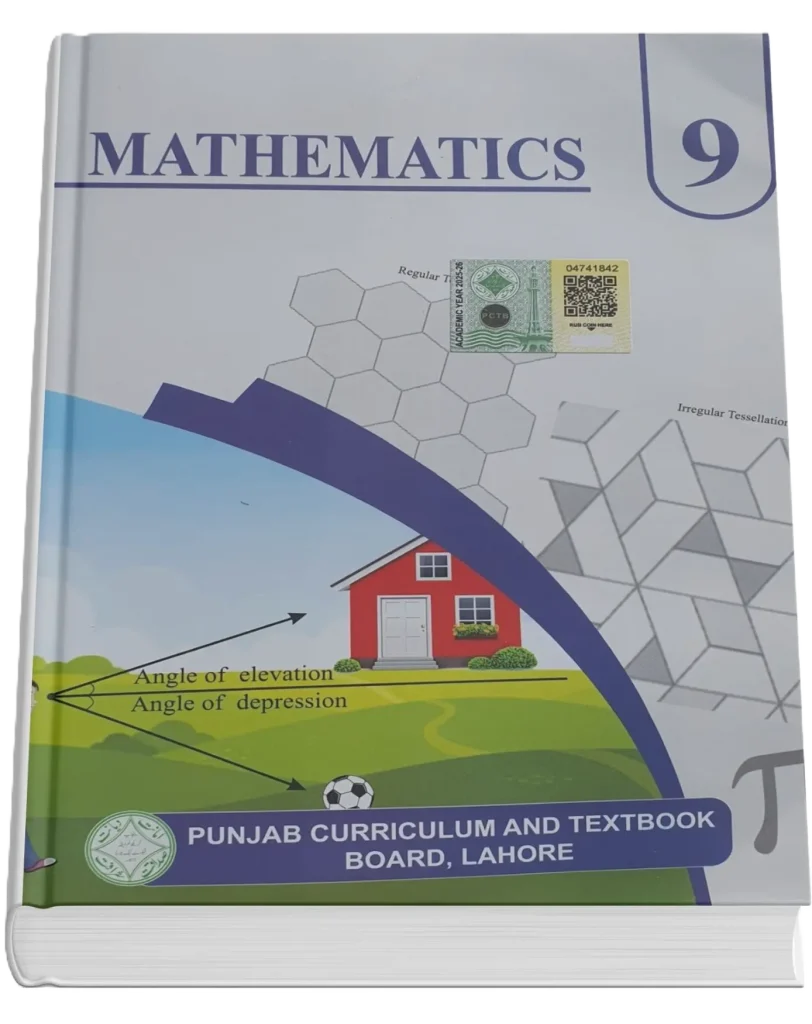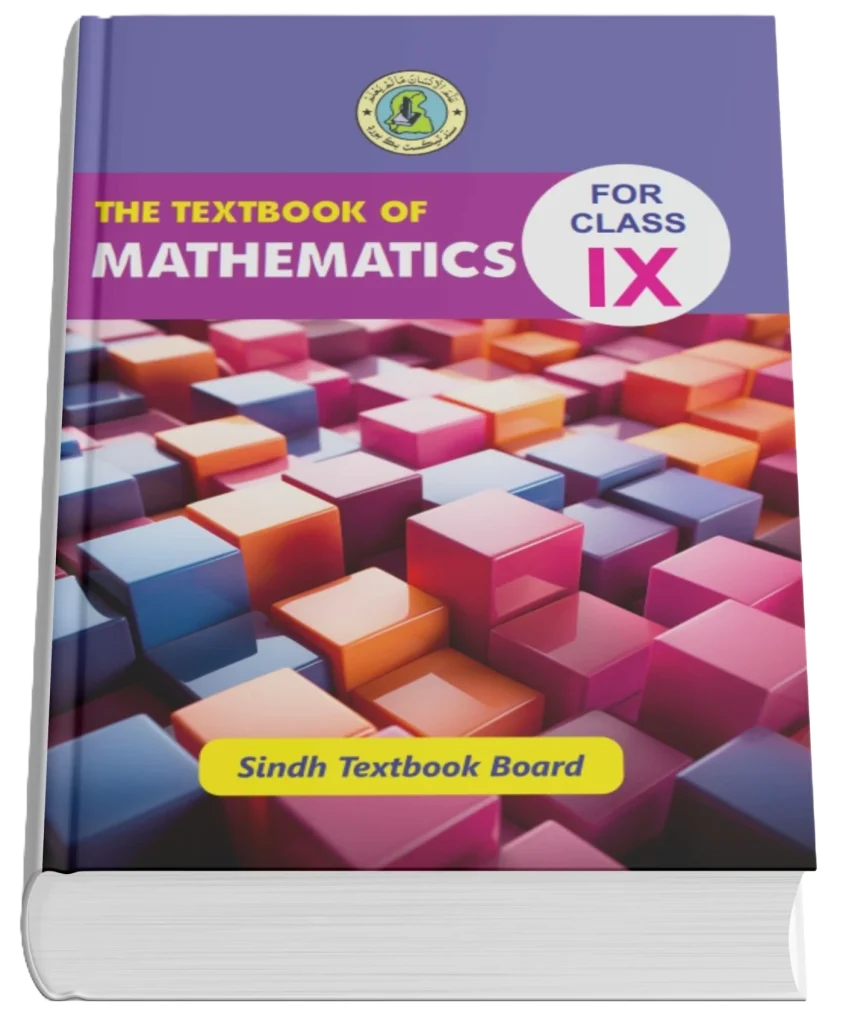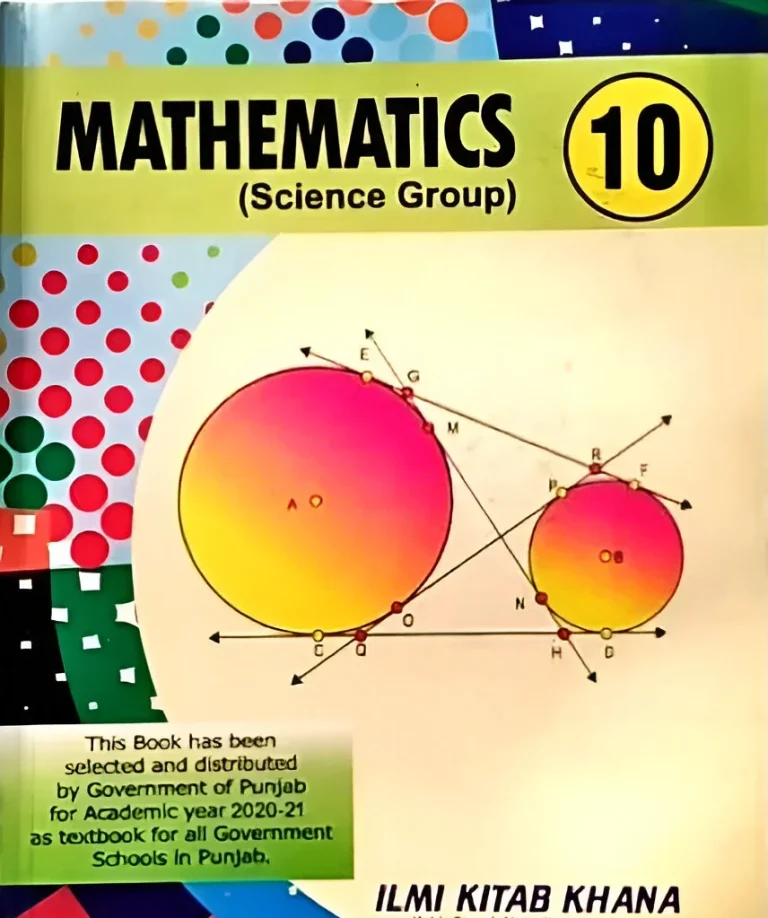9th Class Math Book PDF 2025–26 – Complete & Updated Edition
If you’re looking for the 9th Class Math Book PDF (2025–2026) for Punjab and Sindh boards, you’re in the right place. This updated edition follows the latest syllabus and helps students build a strong foundation for future classes. On this page, you can download the complete 9th class math book and explore simple explanations for every chapter included in the new syllabus.
We’ve also compared the new and old 9th class math books so you can easily see what’s changed this year. Each unit is summarized with key concepts and learning outcomes to help you prepare for board exams more effectively.
Whether you’re studying Real Numbers, Logarithms, or Linear Equations, these notes and book resources will make your learning smoother and more focused. Download the PDF below and start preparing with confidence.
Download 9th Class Math Book
Download the latest 9th Class Math Book PDFs for the 2025–26 session. This page provides both the Punjab and Sindh board editions, each following the updated syllabus and covering essential concepts to help you excel in your studies. These resources are provided solely for educational purposes, and we do not claim ownership of the textbooks. For the official editions, please refer to the Punjab and Sindh boards.


Why the New 9th Class Math Book Matters
Mathematics forms the foundation of logical thinking and problem-solving skills essential for higher education and professional success. The updated 9th class math book represents a paradigm shift from rote memorization to conceptual understanding, preparing students for the challenges of modern education and careers in STEM fields.
Key Benefits of the New Curriculum:
- Streamlined Content: Reduced from 17 to 13 units for focused learning
- Modern Relevance: Topics aligned with current educational standards
- Practical Applications: Real-world examples in every chapter
- Progressive Learning: Smooth transition from 8th to 10th class
- Enhanced Problem-Solving: Emphasis on analytical thinking
Major Changes in the New 9th Class Math Book
The transformation of the 9th class mathematics curriculum represents one of the most significant educational reforms in recent years. Understanding these changes is crucial for students, parents, and teachers to adapt their learning strategies effectively.
What’s Been Removed and Why
The old curriculum included complex topics like Matrices and Determinants and Complex Numbers which were considered too advanced for 9th grade students. Educational experts found that these topics created unnecessary cognitive load, preventing students from mastering fundamental concepts.
Removed Topics:
- Matrices and Determinants (moved to higher classes)
- Complex Numbers (too advanced for this level)
- Multiple triangle theorems (consolidated for clarity)
- Excessive geometric proofs (simplified approach adopted)
What’s Been Added and Enhanced
The new curriculum introduces topics that build a stronger foundation for advanced mathematics while maintaining practical relevance.
Enhanced Focus Areas:
- Real Numbers: Deeper understanding of number systems
- Logic: Critical thinking and reasoning skills
- Information Handling: Data analysis and interpretation
- Probability: Understanding chance and uncertainty
Complete Syllabus Comparison: Old vs New
| Old Book (Previous Edition) | New Book (2025-26 Edition) | Learning Impact |
|---|---|---|
| 1. Matrices and Determinants | 1. Real Numbers | Foundation strengthened |
| 2. Real and Complex Numbers | 2. Logarithms | Practical applications enhanced |
| 3. Logarithms | 3. Sets and Functions | Mathematical thinking developed |
| 4. Algebraic Expressions and Formulas | 4. Factorization and Algebraic Manipulation | Problem-solving skills improved |
| 5. Factorization | 5. Linear Equations and Inequalities | Real-world connections made |
| 6. Algebraic Manipulation | 6. Trigonometry | Spatial reasoning enhanced |
| 7. Linear Equations and Inequalities | 7. Coordinate Geometry | Analytical skills developed |
| 8. Linear Graphs & Their Applications | 8. Logic | Critical thinking fostered |
| 9. Introduction to Coordinate Geometry | 9. Similar Figures | Pattern recognition improved |
| 10. Congruent Triangles | 10. Graphs of Functions | Visual learning enhanced |
| 11. Parallelograms and Triangles | 11. Loci and Construction | Practical skills developed |
| 12. Line Bisectors and Angle Bisectors | 12. Information Handling | Data literacy improved |
| 13. Sides and Angles of a Triangle | 13. Probability | Decision-making skills enhanced |
| 14. Ratio and Proportion | Integrated into other units | Conceptual understanding improved |
| 15. Pythagoras Theorem | Covered in Coordinate Geometry | Application-based learning |
| 16. Theorems Related to Area | Integrated with Similar Figures | Practical geometry focus |
| 17. Practical Geometry – Triangles | Distributed across relevant units | Holistic approach adopted |
Comprehensive Unit-Wise Study Guide
Now, let’s explore each unit in detail with study strategies, common challenges, and exam preparation tips.
Unit 1: Real Numbers – Building Mathematical Foundations
Duration: 3-4 weeks | Weightage: 8-10 marks in board exams
Real Numbers form the cornerstone of all mathematical operations. This unit introduces students to the complete number system that they’ll use throughout their mathematical journey.

Key Learning Objectives:
- Understand the historical evolution of number systems
- Distinguish between rational and irrational numbers
- Master properties of real numbers
- Apply laws of indices and radical expressions
- Solve real-world problems using real numbers
Detailed Topic Breakdown:
- History of Numbers (2-3 periods)
- Evolution from ancient civilizations (Sumerians, Egyptians, Romans)
- Indian and Arab contributions to modern number systems
- Development of decimal system and place value concept
- Understanding Real Numbers (4-5 periods)
- Definition and classification of real numbers
- Rational numbers: fractions, terminating and non-terminating decimals
- Irrational numbers: √2, π, e and their properties
- Number line representation and density property
- Properties of Real Numbers (3-4 periods)
- Closure, commutative, associative, and distributive properties
- Identity and inverse elements
- Order relations and inequalities
- Laws of Indices and Radical Expressions (5-6 periods)
- Basic laws of exponents
- Negative and fractional exponents
- Simplification of radical expressions
- Rationalization of denominators
Common Student Challenges:
- Distinguishing between rational and irrational numbers
- Understanding the concept of infinity in non-terminating decimals
- Applying laws of indices correctly
Study Tips:
- Create a number line poster for your room
- Practice identifying number types daily
- Use calculators to verify decimal expansions
- Connect historical context to modern applications
Sample Problems:
- Prove that √3 is irrational
- Simplify: (2⁻³ × 3²) / (2⁻¹ × 3⁻¹)
- Rationalize: 1/(√5 + √2)
Unit 2: Logarithms – Simplifying Complex Calculations
Duration: 3-4 weeks | Weightage: 6-8 marks in board exams
Logarithms revolutionized mathematics by transforming multiplication into addition, making complex calculations manageable. This unit introduces students to this powerful mathematical tool.
Key Learning Objectives:
- Understand the concept and definition of logarithms
- Distinguish between common and natural logarithms
- Apply logarithmic laws and properties
- Use scientific notation effectively
- Solve logarithmic equations
Detailed Topic Breakdown:
- Scientific Notation (2-3 periods)
- Writing very large and very small numbers
- Operations with scientific notation
- Real-world applications (astronomy, physics, chemistry)
- Introduction to Logarithms (4-5 periods)
- Definition: logₐ(b) = c means aᶜ = b
- Relationship between exponential and logarithmic forms
- Basic logarithmic calculations
- Types of Logarithms (3-4 periods)
- Common logarithms (base 10): log₁₀ or log
- Natural logarithms (base e): ln
- Applications in different fields
- Laws of Logarithms (5-6 periods)
- Product rule: log(ab) = log(a) + log(b)
- Quotient rule: log(a/b) = log(a) – log(b)
- Power rule: log(aⁿ) = n·log(a)
- Change of base formula
Comparison: Common vs Natural Logarithms
| Feature | Common Logarithm | Natural Logarithm |
|---|---|---|
| Base | 10 | e ≈ 2.718 |
| Notation | log(x) or log₁₀(x) | ln(x) |
| Usage | Engineering, general calculations | Higher mathematics, calculus |
| Growth Type | Powers of 10 | Exponential growth |
| Applications | pH levels, sound intensity | Population growth, compound interest |
Real-World Applications:
- pH Scale: Measuring acidity and alkalinity
- Richter Scale: Measuring earthquake intensity
- Decibel Scale: Measuring sound intensity
- Carbon Dating: Determining age of organic materials
- Population Growth Models: Predicting demographic changes
Study Strategies:
- Use calculator functions (log and ln keys) regularly
- Create comparison charts for different logarithm types
- Practice converting between exponential and logarithmic forms
- Solve real-world problems daily
Unit 3: Sets and Functions – Mathematical Language and Relationships
Duration: 4-5 weeks | Weightage: 10-12 marks in board exams
Sets and Functions introduce students to mathematical language and the concept of relationships between mathematical objects. This unit is fundamental for understanding higher mathematics.
Key Learning Objectives:
- Master set notation and operations
- Understand different types of sets
- Define and work with functions
- Determine domain and range of functions
- Represent functions graphically
Detailed Topic Breakdown:
Sets Section (2-3 weeks):
- Understanding Sets (3-4 periods)
- Definition and notation: {a, b, c}
- Element membership: ∈ and ∉
- Set-builder notation: {x | condition}
- Roster method vs set-builder method
- Types of Sets (4-5 periods)
- Finite Sets: {1, 2, 3, 4, 5}
- Infinite Sets: Natural numbers, Real numbers
- Empty Set: ∅ or {}
- Universal Set: U (context-dependent)
- Subset and Proper Subset: ⊆ and ⊂
- Set Operations (5-6 periods)
- Union (A ∪ B): Combining all elements
- Intersection (A ∩ B): Common elements only
- Difference (A – B): Elements in A but not in B
- Complement (A’): Elements not in A
- Symmetric Difference: (A ∪ B) – (A ∩ B)

Functions Section (2-3 weeks):
- Introduction to Functions (4-5 periods)
- Definition: A special type of relation
- Function notation: f(x) = y
- One-to-one correspondence principle
- Domain and Range (3-4 periods)
- Domain: Set of all possible input values
- Range: Set of all actual output values
- Finding domain and range from graphs and equations
- Representing Functions (4-5 periods)
- Graphical Representation: Plotting points and curves
- Tabular Representation: Input-output tables
- Arrow Diagrams: Visual mapping representation
Visual Learning Aid – Sets and Functions Concept Map:
Sets and Functions work together in mathematics:
- Sets provide the foundation for defining domains and ranges
- Functions create relationships between sets
- Operations on sets help understand function properties
Common Exam Questions:
- If A = {1, 2, 3} and B = {2, 3, 4}, find A ∪ B, A ∩ B, and A – B
- Determine if the relation {(1,2), (2,3), (3,1), (1,4)} is a function
- Find the domain and range of f(x) = √(x-2)
Study Techniques:
- Use Venn diagrams for set operations
- Create function machines (input → process → output)
- Practice with real-world examples (student-grade relationships)
- Use graphing tools to visualize functions
Unit 4: Factorization and Algebraic Manipulation – Mastering Algebraic Skills
Duration: 4-5 weeks | Weightage: 12-15 marks in board exams
This unit is crucial for success in algebra and forms the foundation for advanced mathematical concepts. Mastering factorization techniques will make solving equations much easier.
Key Learning Objectives:
- Extract common factors from algebraic expressions
- Factor trinomials and polynomial expressions
- Find HCF and LCM of algebraic expressions
- Simplify complex algebraic fractions
- Apply factorization to solve real-world problems
Detailed Topic Breakdown:
- Common Factors (3-4 periods)
- Numerical Factors: Finding GCD of coefficients
- Variable Factors: Identifying lowest powers
- Mixed Factors: Combining numerical and variable factors
- 6x + 9 = 3(2x + 3)
- 4x²y – 8xy² = 4xy(x – 2y)
- 15a²b³ – 25a³b² = 5a²b²(3b – 5a)
- Factoring Trinomials (5-6 periods)
- Simple Trinomials: x² + bx + c
- General Trinomials: ax² + bx + c
- Perfect Square Trinomials: a² ± 2ab + b²
- Difference of Squares: a² – b²
- Find factors of ‘ac’ that add to ‘b’
- Split the middle term
- Factor by grouping
- Quadratic and Cubic Expressions (4-5 periods)
- Quadratic Factorization: ax² + bx + c
- Cubic Factorization: Using factor theorem
- Sum and Difference of Cubes: a³ ± b³
- Substitution method
- Grouping method
- Trial and error with systematic approach
- HCF and LCM of Algebraic Expressions (3-4 periods)
- Method 1: Complete factorization approach
- Method 2: Division algorithm approach
- Applications: Simplifying complex fractions
- Square Roots of Algebraic Expressions (3-4 periods)
- Perfect Square Recognition: a²b⁴c⁶
- Simplification Techniques: √(a²b) = ab (for positive values)
- Rationalization: Removing square roots from denominators
Real-Life Applications:
- Architecture: Calculating areas and volumes
- Engineering: Optimizing designs and materials
- Economics: Cost-profit analysis and optimization
- Physics: Analyzing motion and energy equations
Common Mistakes to Avoid:
- Forgetting to factor completely
- Sign errors in trinomial factorization
- Not checking answers by expansion
- Ignoring domain restrictions
Practice Strategy:
- Start with simple expressions and gradually increase complexity
- Always verify answers by expanding
- Create your own problems by expanding known factors
- Use online algebra tools to check work
Unit 5: Linear Equations and Inequalities – Problem-Solving Fundamentals
Duration: 4-5 weeks | Weightage: 12-15 marks in board exams
Linear equations and inequalities are fundamental tools for modeling real-world situations and solving practical problems. This unit develops critical analytical thinking skills.
Comprehensive Topic Coverage:
1. Linear Equations in One Variable (1 week)
Core Concepts:
- Standard Form: ax + b = 0 (where a ≠ 0)
- Solution Methods: Systematic approach to isolation
- Verification: Always check solutions by substitution
Problem-Solving Strategy:
- Simplify both sides (combine like terms)
- Isolate variable terms on one side using addition/subtraction
- Solve by multiplying/dividing by the coefficient
- Verify solution by substituting back into original equation
Advanced Examples:
- 3(2x – 1) – 2(x + 3) = 5x – 11
- (x + 2)/3 – (x – 1)/4 = 1/2
- 0.3x + 0.7 = 0.5x – 0.1
2. Linear Inequalities in One Variable (1 week)
Key Rules and Symbols:
- > (greater than), < (less than)
- ≥ (greater than or equal to), ≤ (less than or equal to)
Critical Rules:
- Adding/subtracting constants: Direction unchanged
- Multiplying/dividing by positive numbers: Direction unchanged
- Multiplying/dividing by negative numbers: Direction reverses!
Solution Representation Methods:
- Interval Notation: (-∞, 3), [2, 5), etc.
- Number Line: Open circles (○) for < or >, Closed circles (●) for ≤ or ≥
- Set Builder Notation: {x | x < 5}
3. Linear Inequalities in Two Variables (1 week)
Graphing Methodology:
- Draw Boundary Line: ax + by = c
- Dashed line for < or > (not included)
- Solid line for ≤ or ≥ (included)
- Test Point Method: Usually use (0,0) if not on the line
- Shade Appropriate Region: Based on test point result
Example: Graph x + 2y < 6
- Boundary line: x + 2y = 6 (dashed)
- Test (0,0): 0 + 2(0) = 0 < 6 ✓
- Shade region containing origin
4. Systems of Linear Inequalities (1 week)
Key Concepts:
- Feasible Region: Area satisfying all inequalities simultaneously
- Corner Points: Intersections of boundary lines
- Bounded vs Unbounded: Finite vs infinite feasible regions
Real-World Applications:
- Business: Profit maximization with resource constraints
- Diet Planning: Nutritional requirements with cost constraints
- Manufacturing: Production optimization with material limits
5. Optimization Problems (1 week)
Linear Programming Basics:
- Objective Function: What you want to maximize or minimize
- Constraints: Limitations on variables
- Optimal Solution: Found at corner points of feasible region
Step-by-Step Process:
- Define variables clearly
- Write objective function
- List all constraints
- Graph feasible region
- Find corner points
- Evaluate objective function at each corner
- Select optimal solution
Complete Example: Problem: A factory produces chairs and tables. Each chair requires 2 hours of labor and 1 unit of wood. Each table requires 3 hours of labor and 2 units of wood. Available: 12 hours of labor, 8 units of wood. Profit: $5 per chair, $8 per table. Maximize profit.
Solution:
- Variables: x = chairs, y = tables
- Objective: Maximize P = 5x + 8y
- Constraints: 2x + 3y ≤ 12, x + 2y ≤ 8, x ≥ 0, y ≥ 0
- Corner points: (0,0), (4,0), (2,3), (0,4)
- Evaluation: P(0,0)=0, P(4,0)=20, P(2,3)=34, P(0,4)=32
- Optimal Solution: 2 chairs, 3 tables, Maximum profit = $34
Units 6-13: Advanced Topics Overview
Unit 6: Trigonometry (3-4 weeks, 10-12 marks)
- Introduction to trigonometric ratios (sin, cos, tan)
- Right triangle applications
- Trigonometric identities and equations
- Real-world applications in navigation and engineering
Unit 7: Coordinate Geometry (3-4 weeks, 8-10 marks)
- Cartesian coordinate system
- Distance formula and midpoint theorem
- Area calculations using coordinates
- Linear equations in coordinate form
Unit 8: Logic (2-3 weeks, 6-8 marks)
- Logical statements and truth values
- Truth tables and logical connectives
- Conditional statements and implications
- Mathematical reasoning and proof techniques
Unit 9: Similar Figures (2-3 weeks, 6-8 marks)
- Properties of similar triangles and polygons
- Scale factors and proportional relationships
- Applications in measurement and surveying
- Connection to trigonometry and coordinate geometry
Unit 10: Graphs of Functions (3-4 weeks, 8-10 marks)
- Linear function graphs
- Quadratic function introduction
- Interpreting graphs in real-world contexts
- Domain and range from graphical representation
Unit 11: Loci and Construction (2-3 weeks, 6-8 marks)
- Geometric loci and their properties
- Construction techniques using compass and ruler
- Applications in engineering and design
- Problem-solving through geometric construction
Unit 12: Information Handling (3-4 weeks, 8-10 marks)
- Data collection and organization methods
- Statistical measures: mean, median, mode
- Data representation: tables, graphs, charts
- Introduction to data analysis and interpretation
Unit 13: Probability (2-3 weeks, 6-8 marks)
- Basic probability concepts and terminology
- Sample spaces and events
- Probability calculations and rules
- Applications in decision-making and risk assessment
Study Planning and Exam Preparation
Monthly Study Schedule
Months 1-2 (March-April): Foundation Building
- Units 1-3: Real Numbers, Logarithms, Sets and Functions
- Focus: Conceptual understanding and basic problem-solving
- Practice: 1-2 hours daily, emphasis on understanding
Months 3-4 (May-June): Core Skills Development
- Units 4-6: Factorization, Linear Equations, Trigonometry
- Focus: Skill development and application
- Practice: 2-3 hours daily, mixed practice sessions
Months 5-6 (July-August): Advanced Topics
- Units 7-10: Coordinate Geometry, Logic, Similar Figures, Graphs
- Focus: Integration of concepts and complex problem-solving
- Practice: 2-3 hours daily, previous year papers
Months 7-8 (September-October): Completion and Review
- Units 11-13: Loci, Information Handling, Probability
- Focus: Complete syllabus coverage and revision
- Practice: 3-4 hours daily, mock tests and revision
Months 9-10 (November-December): Intensive Preparation
- Complete revision of all units
- Focus: Exam techniques and time management
- Practice: 4-5 hours daily, board exam papers
Exam Preparation Strategies
Paper Pattern Understanding:
- Total Marks: 85 (written) + 15 (practical)
- Time Duration: 3 hours 15 minutes
- Question Types: MCQs, Short answers, Long answers
- Unit-wise Weightage: Varies by board (Punjab/Sindh)
Time Management Tips:
- Reading Time: 15 minutes to plan approach
- MCQs: 30 minutes (quick and accurate)
- Short Questions: 90 minutes (clear and concise)
- Long Questions: 90 minutes (detailed solutions)
- Review Time: 15 minutes for checking
Common Exam Mistakes to Avoid:
- Not reading questions carefully
- Skipping steps in solutions
- Poor time management
- Illegible handwriting
- Not attempting all questions
Study Resources and Tools
Recommended Study Materials:
- Official Punjab/Sindh Textbook Board books
- Previous 5 years’ board papers
- Supplementary exercise books
- Online video tutorials
- Mathematical software (GeoGebra, Desmos)
Practice Resources:
- Daily practice worksheets
- Weekly mock tests
- Monthly progress assessments
- Peer study groups
- Teacher consultation sessions
Technology Integration:
- Graphing calculators for function analysis
- Online equation solvers for verification
- Educational apps for concept reinforcement
- Virtual manipulatives for geometric concepts
Transition Guide: From 8th Class to 9th Class
Prerequisites from Class 8
Before starting 9th class mathematics, ensure mastery of these 8th class concepts:
- Basic algebraic operations and simplification
- Linear equations in one variable (simple forms)
- Geometric properties of triangles and quadrilaterals
- Basic data handling and simple statistics
- Percentage, ratio, and proportion
Skill Development Areas
Analytical Thinking: Moving from computational to conceptual mathematics Problem-Solving: Multi-step problems requiring strategic planning Mathematical Communication: Expressing solutions clearly and logically Technology Use: Incorporating calculators and software appropriately
Preparation for Class 10: Building Toward Advanced Mathematics
Concepts That Continue to Class 10
- Quadratic Equations: Building on factorization skills
- Trigonometry: Advanced ratios and applications
- Coordinate Geometry: Analytical approach to geometric problems
- Statistics: Advanced data analysis and probability
Skills to Develop This Year
- Algebraic Manipulation: Essential for Class 10 quadratic equations
- Geometric Reasoning: Foundation for advanced geometric proofs
- Graphical Analysis: Critical for understanding function behavior
- Logical Thinking: Necessary for mathematical proof and reasoning
Common Student Challenges and Solutions
Challenge 1: Difficulty with Abstract Concepts
Solution: Use concrete examples and visual aids
- Real-world applications for every concept
- Geometric representations of algebraic ideas
- Step-by-step breakdown of complex problems
Challenge 2: Computational Errors
Solution: Develop systematic checking habits
- Always verify solutions by substitution
- Use estimation to check reasonableness
- Practice mental math regularly
Challenge 3: Time Management in Exams
Solution: Practice with timed assessments
- Regular mock tests under exam conditions
- Develop question prioritization strategies
- Learn to identify high-value questions quickly
Challenge 4: Fear of Word Problems
Solution: Systematic problem-solving approach
- Identify what’s given and what’s required
- Translate words into mathematical expressions
- Practice with gradually increasing complexity
Disclaimer:
The content on this page, including textbook references and downloadable PDFs, is provided solely for educational purposes. We do not claim ownership of the textbooks, nor do we distribute copyrighted material. The resources are shared to assist students in learning and understanding the subjects. For official curriculum, textbooks, and authoritative information, please visit the Punjab Curriculum and Textbook Board and the official Sindh education board websites. While the Punjab board textbooks referenced here are based on the latest editions, the Sindh board textbooks may have differences or updates. Users are advised to cross-check with official materials, as some content may contain minor errors.
Additional Study Materials
- Class 10 Math Book: Complete guide and preparation
- Solved Exercises: Step-by-step solutions
- Important Formulas: Quick reference guide
Online Learning Platforms
- Khan Academy Mathematics courses
- Coursera mathematical thinking courses
- EdX algebra and geometry courses
- YouTube educational mathematics channels
Conclusion: Your Path to Mathematical Excellence
The new 9th class mathematics curriculum represents a carefully designed journey from basic arithmetic to advanced mathematical thinking. By mastering these 13 units, you’re not just preparing for board exams – you’re building the intellectual tools needed for success in higher education and professional careers.
Key Success Factors:
- Consistent Daily Practice: Mathematics is built through regular engagement
- Conceptual Understanding: Focus on ‘why’ not just ‘how’
- Real-World Connections: See mathematics in everyday life
- Collaborative Learning: Study with peers and seek help when needed
- Growth Mindset: View challenges as opportunities to improve
Remember, mathematics is not about memorizing formulas – it’s about developing problem-solving skills, logical thinking, and analytical abilities that will serve you throughout life. The new curriculum emphasizes these transferable skills while maintaining the rigor necessary for academic success.
Start your mathematical journey today by downloading the book and following this comprehensive study guide. With dedication, proper planning, and the right resources, you can excel in 9th class mathematics and build a strong foundation for your future academic endeavors.
Ready to begin? Download your 9th Class Math Book now and embark on this exciting mathematical adventure!
For updates on curriculum changes or additional study resources, regularly visit the official Punjab and Sindh Textbook Board websites. Stay connected with your teachers and fellow students for collaborative learning and support.


One Comment